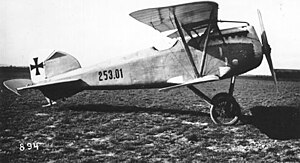Albatros D.III(Oef)
| Albatros D.III(Oef) | |
|---|---|

| |
| Role | Fighter |
| Manufacturer | Oeffag |
| First flight | Feb 1917[1] |
| Introduction | June 1917[2] |
| Primary user | |
| Number built | ~650[3] |
| Developed from | Albatros D.III |
| Wingspan | 9.0 m (29 ft 6 in)[2] |
| Engine | 185-225hp Daimler inline |
| Armament | 2×fixed sync. Schwarzlose MG |
| Crew | 1 |
| Max Speed | see table |
| Climb | see table |
Oeffag built Albatros D.IIIs for Austria-Hungary in three series (53, 153, and 253), including improvements to the airframe and wing and the provision for more powerful Daimler engines. 656 Austro-Hungarian D.IIIs were ordered, and they were remained in production until the end of the war.[3]
The Series 53.2 began with the basic German D.III design, but the wing and airframe were strengthened. This corrected one of the D.IIIs greatest weaknesses: failure and twisting of the lower wings, especially at their roots. The 185hp engine also gave the D.III more speed than its German counterpart. As production progressed, minor problems that were found were corrected, and the planes only got better in each successive series.
The Series 153 discarded the spinner, which tests showed did little to improve aerodynamics. The twin guns were buried in the fuselage with only the butts exposed, making it difficult to clear jams. The 153 was a capable, robust fighter that held its own and scored more victories than any other Austro-Hungarian fighter.
As solid as the Series 153 planes were, the Series 253 D.IIIs were an improvement. Pilots praised it as the best fighter available, with "peerless" flight characteristics, complaining only that there were too few of them. The guns were raised to a higher position, but reviews on the change were mixed, and Series 253 planes were built with both configurations. [3]
| Albatros D.III(Oef) Series[3] | |||||
|---|---|---|---|---|---|
| Series | Engine | Intro Date | Built | Speed | Climb |
| Series 53.2 | 185hp Daimler | June 1917 | 45 | 180 km/h (112 mph)[2] | 1,000 m (3,280 ft) in 3:20[2] 3,000 m (9,840 ft) in 14:30[2] 5,000 m (16,400 ft) in 32:00[2] |
| Series 153 | 200hp Daimler | autumn 1917 | 281 | 188 km/h (117 mph)[4] | 1,000 m (3,280 ft) in 2:35[4] 3,000 m (9,840 ft) in 11:20[4] 5,000 m (16,400 ft) in 33:00[4] |
| Series 253 | 225hp Daimler | June 1918 | 230[note 1] | 202 km/h (126 mph)[5] | 1,000 m (3,280 ft) in 3:05[5] 3,000 m (9,840 ft) in 11:20[5] 5,000 m (16,400 ft) in 27:00[5] |
For more information, see Wikipedia:Albatros D.III.
Timeline

Game Data
Wings of Glory
| Version | Availability | Maneuver | Damage | Dmg Points | Max Alt. | Climb |
|---|---|---|---|---|---|---|
| Series 153 | 17Q3-18Q4 | B | A | 15 | 13 | 2 |
| Series 253 | 18Q2-18Q4 | A | A | 15 | 13 | 2 |
Plane and Crew Cards
-
Flik 55/J
Arigi
RAF -
Flik 41/J
Brumowski
RAF -
Flik 61/J
Hautzmayer
RAF -
Flik 42/J
Hefty
RAF -
Flik 55/J
Kenzian
RAF -
Flik 55/J
Kiss
RAF -
Flik 55/J
Maier
RAF -
Flik 3/J
Navratil
RAF -
Flik 63/J
Němec
RAF -
RAF -
Flik 3/J
Peter
Guntruck -
Kosciuszko
Guntruck
Card Links
Miniatures and Models
1:144 Scale
- Full-Color Miniatures
- Ares: WGF118B Gruber (Series 53.2)
- Reduced Aircraft Factory: Arigi (153.80), Brumowski (153.45), Hautzmayer (153.32), Hefty (253.64), Kenzian (153.27), Kiss (153.47), Maier (153.185), Navratil (253.116), Němec (253.32), Pride Colors (non-historical)
- Wings of War: Brumowski, Hautzmayer
- Shapeways
- Series 53.2: Reduced Aircraft Factory
- Series 153: Reduced Aircraft Factory
- Series 153 late: Reduced Aircraft Factory, wow
- Series 253: Columbia Aerodrome (cowled), Columbia Aerodrome (open engine), Reduced Aircraft Factory
1:200 Scale
- Shapeways: wow (Series 153)
1:285/6mm/1:288 Scale
- Shapeways:
- Series 53.2: Reduced Aircraft Factory
- Series 153: Reduced Aircraft Factory
- Series 153 late: Reduced Aircraft Factory
- Series 253: Reduced Aircraft Factory
Resources
Orthographic Drawings
-
Series 53.2
-
Series 153, early, cowled
-
Series 153, late
-
Series 253
References
- Notes
- Citations
- Bibliography
- Peter M. Grosz, George Haddow, and Peter Schiemer. Austro-Hungarian Army Aircraft of World War One. Flying Machines Press, 1993. ISBN 0-9637110-0-8.















